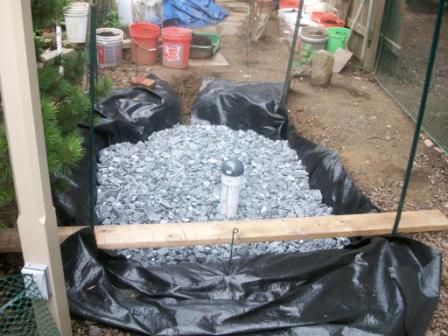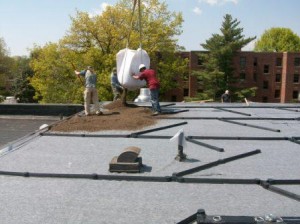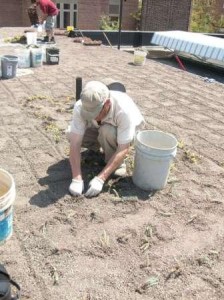Advanced – I’ve got 5 days (or more)
Replace Toilets, Install Low-Flow Faucets and Waterless Urinals
Depending on the number of employees, bathrooms can utilize a lot of water. Toilets use about 40 percent of the water we use in our buildings – up to 3.5 gallons per flush. The Environmental Protection Agency (EPA) states that in the U.S. more than 4.8 billion gallons of water are flushed down toilets each day. Replacing your toilet with a low-flush or dual-flush model can reduce water usage significantly (on average 2 gallons per flush). Low-flow faucets and waterless urinals can further reduce water usage in bathroom facilities.
Install a rainwater collection system
The effectiveness of any system is a function of the total storage volume in comparison to amount of runoff generated by your property. Rainwater collection systems can generate non-potable water for things like irrigation, gray water use for cleaning equipment, cooling mechanical equipment, etc. and can be customized to your needs.
Typically, collection systems for commercial properties include cisterns, large underground tanks that can hold thousands of gallons of water.
Cistern / Rain Barrel (PDF)
Install Pervious Pavement
Installing pervious pavement is a technique that combines stormwater infiltration, storage and structural pavement consisting of a permeable surface underlain by a storage/infiltration bed. Pervious pavement is well suited for parking lots, walking paths, sidewalks, and patios. Pervious Pavement with Infiltration (PDF)
Soak It Up!
Infiltration practices are natural or constructed areas that slow, filter and absorb stormwater. They also attract and provide habitat for butterflies and birds, and serve as attractive landscaping. Infiltration practices can include:
- Vegetated Swale/Tree Trench – a shallow, linear bed typically composed of a stone trench that is planted with a variety of grasses, shrubs and/or trees designed to slow, filter and infiltrate stormwater. They are an excellent alternative to curbs along driveways or other areas on your property where water naturally flows. Vegetated Swale (PDF)
- Rain Garden – a shallow landscaped area that requires removing some portion of the existing soil and replacing it with a sandy soil mix that can hold and filter several inches of water. In addition, rain gardens are planted with specially selected native plants that can hold up in wet conditions. Bioretention (Rain Garden) (PDF)
- Dry Wells – small, excavated pits typically about 4-6’ deep, filled with stone or gravel that temporarily store stormwater runoff until it infiltrates into the surrounding soil. A downspout can connect directly to a dry well. Infiltration Practices (PDF)

Install a Green Roof
Green roofs are layers of living vegetation installed on top of buildings, from small garages to large industrial structures. They help manage stormwater and contribute to improved water quality by retaining and filtering rainwater through the plant’s soil and root uptake zone. The water that does leave the roof is slowed, kept cooler and is filtered to be cleaner. Green roofs can also further insulate the building, reducing cooling and heating costs for your commercial property. Key considerations for implementing green roofs include the structural and load-bearing capacity of the building, plant selection, waterproofing, and drainage or water storage systems.
In addition to the stormwater benefits, green roofs extend the life of the gray roof beneath it two to three times. They can help preserve habitat and biodiversity in an otherwise sterile urban environment. Green roofs can also improve air quality by helping to reduce the urban heat island effect. Finally, they can provide garden areas and attractive views .
Vegetated Roof (PDF)
The two most effective types of green roofs are:
- Extensive systems – With 3 – 4 inches of soil and 12 – 40 pounds per square foot of roof area and short plants with shallow root systems, this type of green roof requires only minimal maintenance. Extensive systems absorb stormwater and improve water quality.
- Intensive systems – These systems are similar to gardens on the ground. They have a minimum of 6 -12 inches of soil and weigh 80 -150 pounds per square foot, host deeper-rooted plants including shrubs and trees and require more maintenance.
For more information on the Lancaster Green Roof program please contact, fschroeder@lancasterconservancy.org, 717-392-7891 x 207.


Plan a Community Tree Planting.
Ready to do more outreach in the community and get your company’s name associated with a great cause? Lancaster City welcomes corporate participation in helping to fund the planting of trees along streets, parks and in the public right of way. This can be a fantastic team-building exercise while providing positive publicity for your business.
Interested? Please contact, fschroeder@lancasterconservancy.org, 717-392-7891 x 207.

